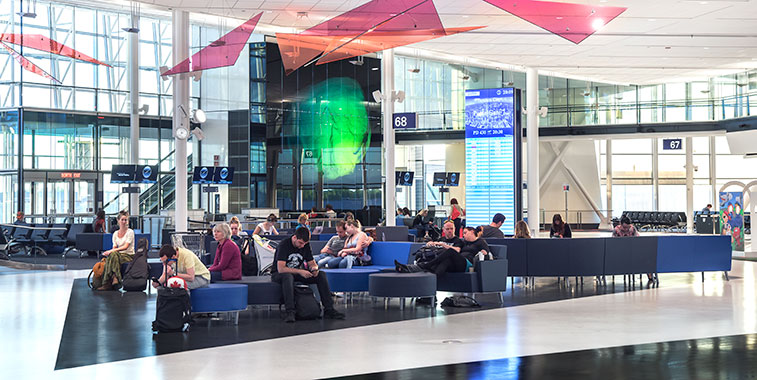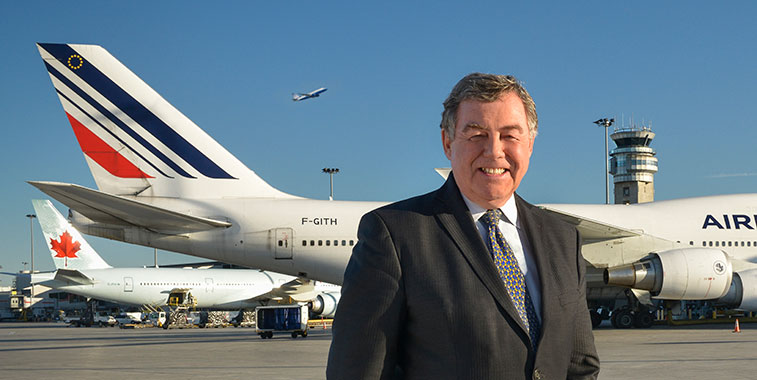Montréal-Trudeau is truly a destination in itself – “functional and vibrant, as well as emblematic of Montréal.” On its 75th anniversary, James Cherry, President and CEO, Aéroports de Montréal, outlines the operator’s main goals to enhance the passenger experience and to be an efficient transportation hub, to Marta Dimitrova.

In May 2016, ADM inaugurated $350 million (€313m) worth of expansion and improvements at Montréal-Trudeau. The main innovation is the development of an interior area designed to create a unique atmosphere, including a lighted ceiling installation, Nuée de verre (Veil of Glass), composed of different-coloured glass triangles illuminated by spotlights.
Aéroports de Montréal’s (ADM) master plan vision is clear – to increase the capacity of the international sector and enhance the customer experience. The plan also aims to create a facility “both functional and vibrant, as well as emblematic of Montréal,” explains James Cherry, President and CEO, Aéroports de Montréal.
Located just 20 minutes from the heart of Canada’s second largest city, Montréal-Trudeau has emerged as a growing transportation hub and major European gateway for North America, last year welcoming 15.5 million passengers.
In May 2016, ADM inaugurated $350 million (€313m) worth of expansion and improvements at Montréal-Trudeau, which have significantly increased the capacity of its international services and enhanced the customer experience.
The new, highly innovative facilities include an extension to the international jetty, which offers six new boarding gates to handle more wide-body Airbus A380 and Boeing 787 aircraft, as well as the equivalent of two additional gates accessible by shuttle. Six super jumbo jets can now park at the same time around the new building, and the additional remote parking significantly improves airport capacity during peak periods, alleviating congestion and allowing for most of the aircraft to be brought closer to the terminal. This offers significantly more convenience for passengers and increases overall fluidity and turnaround time.
Destination Montréal-Trudeau
The project, financed entirely by ADM without any public funding, “has been completed showing imagination and taking into account our limited financial resources,” Cherry comments.
The main innovation, however, is the development of an interior area designed to create a unique atmosphere through the integration of artistic and cultural elements, including a lighted ceiling installation, called Nuée de verre (Veil of Glass) composed of different-coloured glass triangles illuminated by spotlights. “Although representing a small percentage of the budget, it is these little extras, in conjunction with the open plan, transparent architectural design, that makes all the difference,” Cherry notes.
Moreover, the expansion has added a distinctive range of new commercial offerings to enhance the travel experience, including restaurants and boutiques, VIP lounges, and an innovative rest area called ‘Room to Read’, as well as a children’s playground. Visitors can enjoy well-known local brands and experience the variety of restaurants, which make the airport truly stand out and become a destination itself. In total, some 800sqm of new retail space was added and by the end of 2016 Montréal-Trudeau’s retail floor space will total 14,585sqm, which will mark an increase of approximately 38% compared with five years ago.
The new international jetty was also built in keeping with ADM’s sustainable development philosophy by using green building materials, energy saving ventilation and heating systems, LED lighting, and devices to reduce water consumption. ADM is currently in the process of applying for LEED certification for the building.
“Our goal was to infuse the airport facilities with a typically Montréal character, while creating an atmosphere that is both pleasant and festive, even playful,” Cherry states. “The result we call the ‘Aérogalerie’, which aims to infuse the terminal spaces with a typically Montréal character, while supporting local artists and cultural industries.”
“We are also at the forefront when it comes to mobile technologies,” Cherry adds. ADM has ensured that Montréal-Trudeau is a pioneer in shared facilities, such as self-service check-in, self-tagging baggage, self-service baggage drop-off, automated flow tracking of passengers and baggage, and automated border control (ABC). “All of these technologies and approaches are playing an integral role in our goal of ensuring a seamless, smooth and smart journey for airport passengers, every step of the way,” Cherry enthuses.
Since 2004, Montréal-Trudeau has steadily expanded and enhanced its technology offerings, including the introduction of free WiFi; real-time SMS alert; online reservations to ‘SecurXpress’, a new service allowing passengers to book a predetermined time for security clearance; as well as the airport’s mobile application YUL, designed to serve as a personal assistant for Montréal-Trudeau users. ADM adapts to passengers’ needs, allowing more options, personalisation and customisation, to put passengers in control of their journeys.
Meanwhile, the airport set a new record with 3.9 million passengers in Q1 2016, and by the end of this year is expected to welcome approximately 16 million passengers. “Traffic at Montréal-Trudeau has been growing almost continuously since 2004,” says Cherry. “Part of the reason is our strategy to make the airport a dynamic hub linking North America and Europe, especially French-speaking countries. Connecting traffic through the airport has shown dramatic growth.”
Furthermore, over the past decade, the number of international destinations served by direct flights from the airport has more than doubled from 30 to 80. With its growing role as a regional hub, Montréal-Trudeau has also been experiencing a sharp increase in connecting passenger traffic: international-to-international traffic has been growing by 8-10% a year, and international to the US and vice-versa by over 20%. About 20% of total passengers are now connecting to other flights and destinations, which is much higher than it’s ever been.

James Cherry, President and CEO, Aéroports de Montréal, comments that ADM’s ultimate goal is “continuous improvement of the passenger experience”.
In terms of route development strategy, the airport’s route network continues to grow, and since September last year the airport has added seven cities to its list of destinations, including Beijing, Reykjavik, Denver, Tunis, and Glasgow. “These are results delivered through an effective ASD (air service development) strategy,” Cherry comments. “There is still work to be accomplished, and attracting additional services from Asia remains a cornerstone of ADM’s strategy. We are clearly underserved in our connectivity to East Asia, such as to Hong Kong and Japan. We also see increased demand for more direct traffic to the Middle East and Africa, and a new service to South America.”
The new jetty, moreover, will certainly help ADM achieve its goal of strengthening Montréal-Trudeau’s role as an efficient transportation hub between North America and Europe. With 30 airlines offering direct flights to more than 135 destinations worldwide, it already ranks second among Canadian airports for the number of direct destinations and first in terms of the ratio for international passenger traffic. Over the past 18 months, ADM has welcomed four new airlines – Air China, Icelandair, WOW air, and Tunisair – while the established carriers Air Canada, Lufthansa, and Air Transat added capacity from Montréal on their respective routes to Geneva, Munich, Paris and Lyon. This summer, Air Canada launched new long-haul services to Denver, Houston, and Philadelphia.
As Montréal-Trudeau celebrates its 75th anniversary this year, the airport’s vision is to be a solid, evolving, state-of-the art and performing airport, and an efficient transportation hub. “We are constantly exploring new avenues to improve Montréal-Trudeau’s airport facilities and services in response to the evolving needs of the travelling public. Our goal is to provide airlines and their customers with a level of service that is beyond compare,” concludes Cherry.







